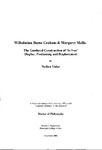Wilhelmina Barns-Graham & Margaret Mellis - The Gendered Construction of 'St Ives' Display, Positioning and Displacement
| dc.contributor.author | Yakir, Nedira | |
| dc.contributor.other | Faculty of Arts, Humanities and Business | en_US |
| dc.date.accessioned | 2013-11-05T11:02:21Z | |
| dc.date.available | 2013-11-05T11:02:21Z | |
| dc.date.issued | 2002 | |
| dc.identifier | NOT AVAILABLE | en_US |
| dc.identifier.uri | http://hdl.handle.net/10026.1/2591 | |
| dc.description | Merged with duplicate record 10026.1/708 on 27.03.2017 by CS (TIS) | |
| dc.description.abstract |
Compared to other avant-gardes of modernism the detailed analysis of what has come to be known as the 'St Ives School' is still in its infancy, and lags behind the detailed attention lavished on modernisms in Paris, New York and other western capitals. Most publications about St Ives are by English non-academic agents: The Tate, and popularist writers. Both groups are entrenched to varying degrees in monographic writing that privileges and enhances the masculine myth of the (male) artist as genius. This thesis examines the means and modes that brought about masculine reputation construction and aims to deconstruct much of its assumptions. The First chapter examines the textual evaluative procedures that predominate in art historical writing; the second chapter describes, analyses and deconstructs the 1985 exhibition at the Tate Gallery London, as an event that established the myth and canon of the so-called school of St Ives. Chapters three and four focus on two women painters Margaret Mellis and Wilhelmina Barns-Graham that I argue have been expunged from the school. Both chapters address two consecutive issues: first the artistic milieu, or artworld the artists were involved in, second- their artistic output. This thesis does not present a survey of any kind, instead it aims to render the dominant narrative unstable, and to open up gaps for my intervention so as to redress the imbalances rooted within this topic and question some of its assumptions, mainly in relation to women painters. I have used Bourdieu's notion of habitus both as an overall structuring principle and as a methodological tool in linking the societal and individual so as to expose the gendered imbalance of appraisal in both domains of structure and artistic subjectivity. | en_US |
| dc.language.iso | en | en_US |
| dc.publisher | University of Plymouth | en_US |
| dc.title | Wilhelmina Barns-Graham & Margaret Mellis - The Gendered Construction of 'St Ives' Display, Positioning and Displacement | en_US |
| dc.type | Thesis | |
| plymouth.version | Full version: final and full version as approved by the examiners at the time of the award of your degree | en_US |
| dc.identifier.doi | http://dx.doi.org/10.24382/4358 |
Files in this item
This item appears in the following Collection(s)
-
01 Research Theses Main Collection
Research Theses Main


